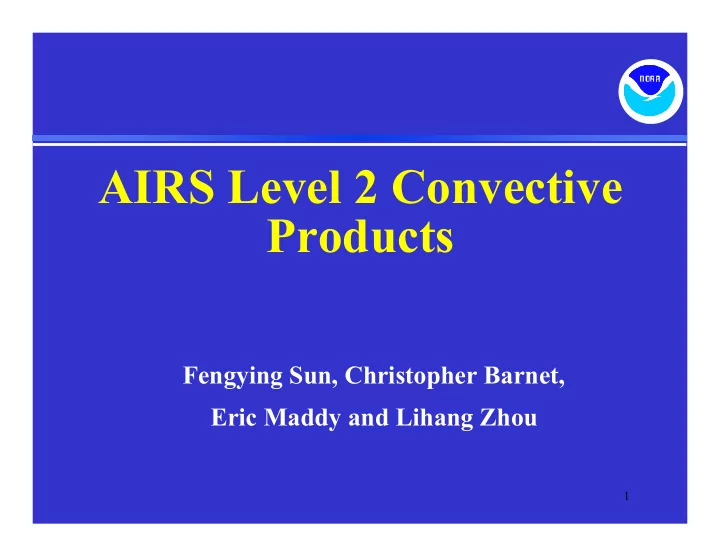

AIRS Level 2 Convective Products Fengying Sun, Christopher Barnet, Eric Maddy and Lihang Zhou 1
Outline of talk Motivation Motivation 1. 1. What are convective parameters? What are convective parameters? 2. 2. Comparison with GOES products Comparison with GOES products 3. 3. Relation to severe weather Relation to severe weather 4. 4. Summary and future plans Summary and future plans 5. 5. 2
Motivation • CAPE (Convective Available Potential Energy), CIN (Convective Inhibition) and LI ( Lifted Index) are routine products for GOES • Derived from temperature and moisture profiles from MIT, regression and physical algorithms • Wanted to see if 50km retrieval products could supply useful information • Convective products provide awareness of convective potential in evolving storm environments 3
What are convective parameters? Parcel method and skew-T log(p) diagram 4
CAPE: Convective Available Potential Energy (Positive Area) T T � z EL = CAPE g dz v v = � T z LFC = V The amount of energy available to a parcel as it freely rises between LFC and EL. 0 − 1000 marginally unstable 1000 − 2500 moderately unstable 2500 − 3500 very unstable ≥ 3500 extremely unstable 5
CIN: Convective Inhibition (Negative Area) T T � z LFC = CIN g dz v v = � T z SFC = V The amount of energy that must be supplied to a parcel for it to rise to LFC. < 15 fair weather cumulus field (CIN overcome early) 15 − 50 a few strong thunderstorms may form (if CIN is overcome) 50 − 150 strong thunderstorms may form (if CIN is overcome) > 200 strong capping inversion present and thunderstorm development unlikely (CIN usually difficult to overcome) 6
LI: Lifted Index LI = T500 -Tp500 LI = T500 -Tp500 The difference between the 500 hPa temperature (T500) and the lifted parcel's temperature (Tp500). > 0 stable conditions, but convection possible for LI = 1 − 3 if strong lifting is present 0 − -3 marginally unstable -3 − -6 moderately unstable -6 − -9 very unstable < -9 extremely unstable 7
Algorithm Algorithm Investigating the differences between the many methods calculating CAPE and other stability indices. • Origin of parcel (surface, max( θ e ), max(CAPE)). • Formulation of saturation vapor pressure. • Formulation of θ e : Many formulations out there (Simpson, Betts, Bolton, Holton, etc). Our implementation based on Our implementation based on McIDAS McIDAS 8
FORTRAN Subroutine FORTRAN Subroutine conv_ _parat parat conv ( (iprt iprt,pres,temp, ,pres,temp,wcd wcd, ,psurf psurf, ,liftflag liftflag, ,nstabil nstabil, ,stabil stabil) ) CAPE : Convective Available Potential Energy (J/kg) CIN : Convective Inhibition (J/kg) LI: Lifted Index (T500-Tp500) (C) LCL: Pressure at the Lifted Condensation level (hPa) LFC: Pressure at the Level of Free Convection (hPa) EL: Pressure at the Equilibrium level (hPa) TLCL: Temperature at LCL (K) TLFC: Temperature at LFC (K) θ : potential temperature of the lifted parcel (K) 9 θ e : Equivalent potential temperature of the lifted parcel (K)
Comparison with GOES products Comparison with GOES products 10
Comparison of NOAA/NESDIS Comparison of NOAA/NESDIS GOES Sounder Temperature and Moisture GOES Sounder Temperature and Moisture Products (left) and AIRS products (right) Products (left) and AIRS products (right) ) ) 11
CAPE from CIMSS Realtime Realtime GOES GOES CAPE from CIMSS Products (left) and AIRS products (right) Products (left) and AIRS products (right) 12
LI from GOES sounding (CIMSS/SSEC, LI from GOES sounding (CIMSS/SSEC, left) and AIRS (right) left) and AIRS (right) 13
Relation to severe weather Relation to severe weather 14
Tornado, wind and hail reports (SPC) from 05/25/06 12Z to 05/26/06 12Z 15
Daily observed precipitation (NWS) Daily observed precipitation (NWS) from 05/25/06 12Z to 05/26/06 12Z 16
Surface-based CAPE: Lift parcel from Surface-based CAPE: Lift parcel from surface surface 17
Maximum CAPE: Lift parcel from the layer Maximum CAPE: Lift parcel from the layer of maximum ( θ e ) ) of maximum ( 18
Surface-based LI: Lift parcel from surface Surface-based LI: Lift parcel from surface 19
Maximum LI: Lift parcel from the layer of Maximum LI: Lift parcel from the layer of maximum ( θ e ) ) maximum ( 20
Summary Summary • The implementation of the algorithm is an simple interface — can add and reduce instability parameters as users request. • Convective parameters can be computed from MIT, regression, and physical retrieval. • CAPE, CIN and LI are good indicators of the potential for strong thunderstorms and severe weather. 21
Future Plans Future Plans • Convective products from AIRS and IASI, 4 times/day • Near real - time system, explore the utility of evolving storm warnings (Nowcaster community) minimizing false alarms 22
Recommend
More recommend